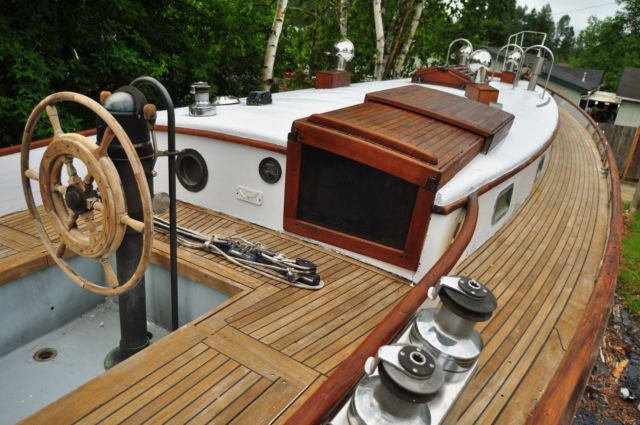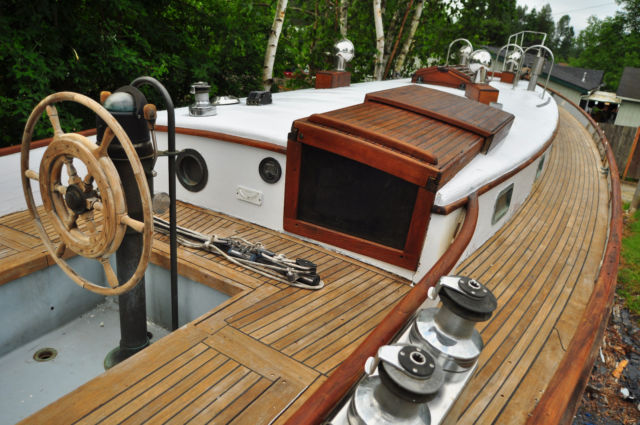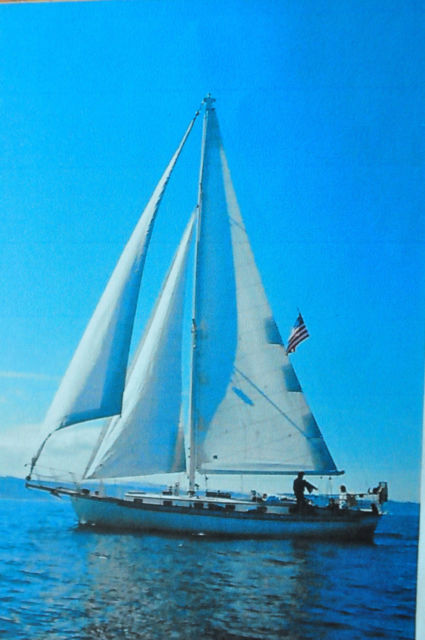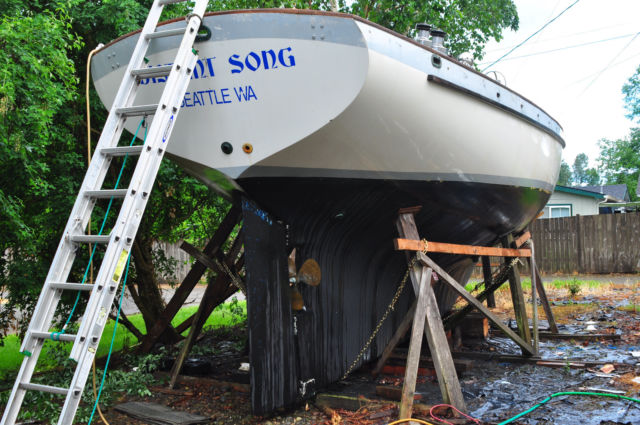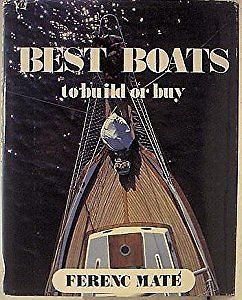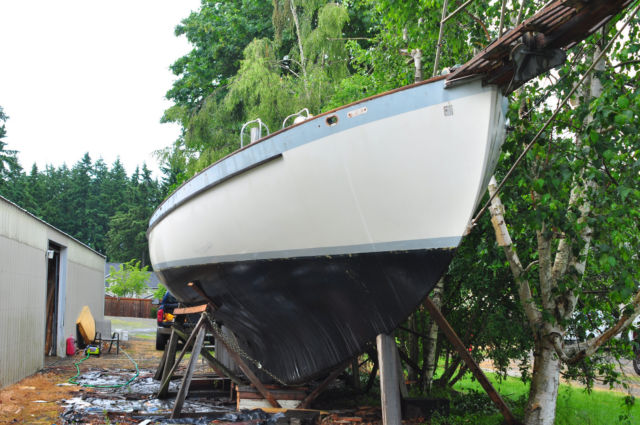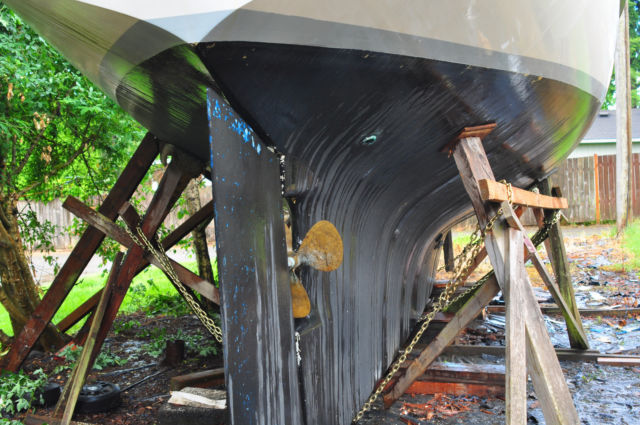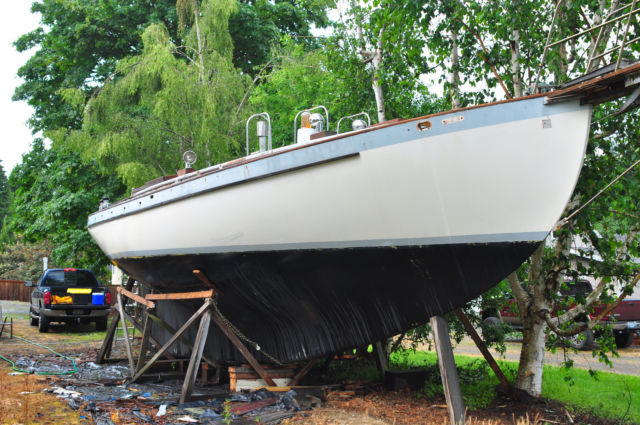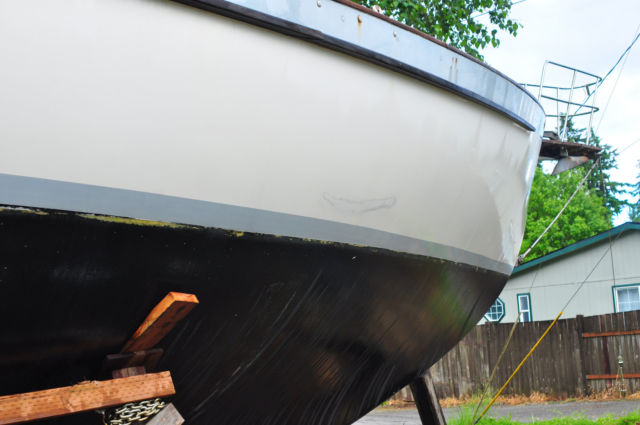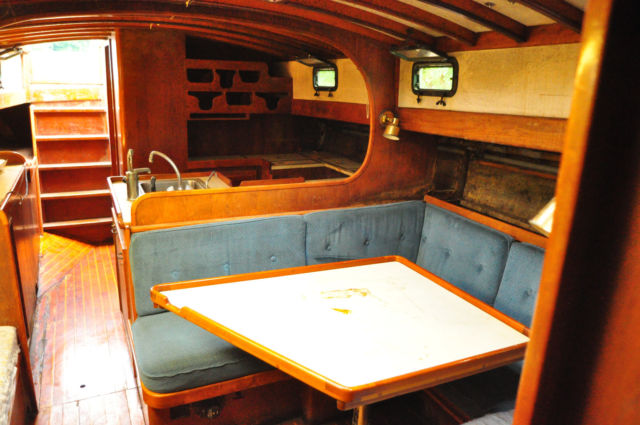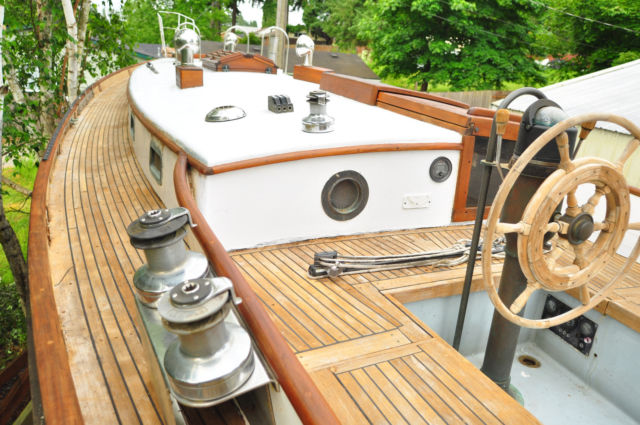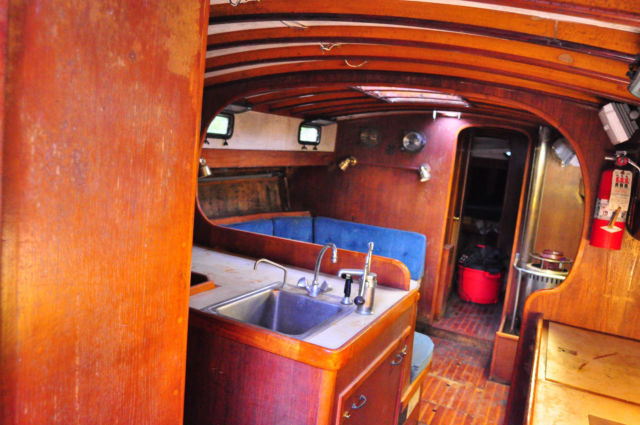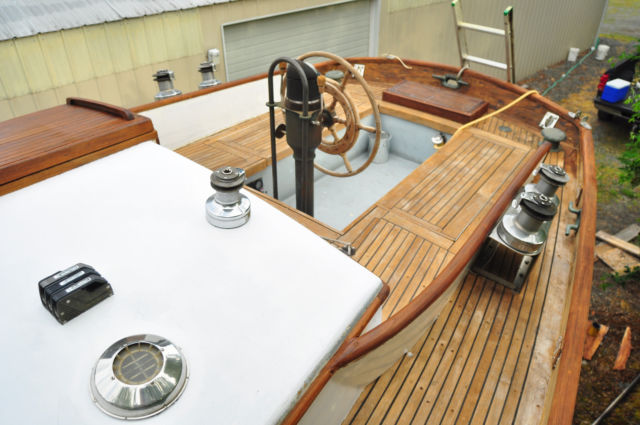No Reserve -True Auction WORLD'S MOST PERFECT DESIGN ATKINS 40 FT GLOBAL CRUISER
1984 CECIL M. LANGE -CAPE GEORGE YACHTS 40 BILL ATKINS DESIGNED - CECIL 40
- Price: Contact seller
- Make: CECIL M. LANGE -CAPE GEORGE YACHTS 40
- Model: BILL ATKINS DESIGNED - CECIL 40
- Type: WORLD CAPABLE BLUE WATER CRUISER
- Year: 1984
- Location: Puyallup, Washington, United States
Description
Mast is currently un-stepped and boat is ready to be moved by boat mover. Boat must be moved from private residence by professional boat mover before end of July. Please factor the cost of that into your purchase. Payment due in full within 24 hours. These boats are very sought after world cruisers, considered by many the best hull and keel design ever created for world cruising, FAST, TOUGH, STABLE and not too deep.PLEASE READ THE ENTIRE TEXT OF THE DESCRIPTION TO GET A COMPLETE PERSPECTIVE ON YOUR CHOICES WHEN SEARCHING FOR A GOOD QUALITY CRUISING SAILBOAT. CALL ME IF YOU HAVE ANY QUESTIONS.
WILLIAM 970 319-4361
PAYMENT IS DUE IN FULL WITHIN 24 HOURS. PLEASE BID ONLY AS MUCH AS YOU HAVE ON HAND TO SPEND, AND CONSULT WITH YOUR SPOUSE OR CRUISING PARTNER(S) PRIOR TO PLACING YOUR BID.
YOUR BID IS A LEGALLY BINDING CONTRACT TO PURCHASE THIS FINE PROJECT SAILBOAT. THE FINAL FEW MINUTES OF THE AUCTION SOMETIMES DETERMINE WHO WINS THE BIDDING, SO IF YOU ARE A SERIOUS BUYER MAKE SURE TO SET THE ALARM ON YOUR PHONE TO TUNE IN FOR THE FINAL FEW MINUTES OF THE AUCTION TO MONITOR YOUR STATUS. Auction closes middle of the day on Wednesday.
The Importance of Buying a Good Vessel
If you were planning an expedition across the African savanna, thousands of miles long, through rutted dirt and mud roads with river crossings and across sand dunes where the tire tracks disappear in the sane with ever new dust storm, would you try to save money and outfit a Ford Escort for the trip; or would you spend ten times as much money to get a fully equiped expedition style Land Rover with all the spare parts to fix anything that might possibly break and leave you stranded?
In long distance cruising far too many folks have no clear idea of the seriousness of the adventure before them, and they set out with big dreams of crossing the African Serengetti...”in a Ford Escort.”
There are literally tens of thousands of sailboats in the world that are perfect for comfortable weekend sailing on lakes and fair weather coastal cruising. But as soon as you begin to dream and plan for the huge lifestyle altering adventure of actual ocean cruising, whether that means trips of a few hundred miles along the U.S. east or west coast or going event further, to faraway exotic islands, the type of vessel that is required by that expedition changes dramaticly.
To do it safely, ocean cruising is an expensive lifestyle choice. For centuries, sailing into the open ocean in your own vessel was a luxury only the super wealthy could afford. The 20th century certainly made the lifestyle more accessible to the upper middle classes, especially for lake sailing and coastal cruising. But still to this day, equiping a proper ocean going vessel carries a hefty price tag. And there really aren't any ways to skimp without compromising your own safety. Deals that seem too good to be true almost always are too good to be true. There are simply too many smart and resourceful (and experienced) sailors out there looking for the good deals on the best boats. Unless your uncle is super wealthy and dies and leaves you a half million dollar yacht in his will, or something like that, there really isn't a way to get a safe and well kept cruising yacht with all the necessary equipment without paying a fairish price for it. In 99.99% of cases when you buy a boat, even on Ebay, you will be getting what you pay for. If you are serious about real ocean cruising you have three good choices and one bad choice.
1. The Bad Choice – You can go to sea in a nice, clean, pretty and cheaply-built vessel. Of course all the boat manufactures who build these boats have lots of slick publicity material to make you think that these are quality vessels, but put it into the gulfstream in multi-dimensional five-foot pounding seas with a 25 knot breeze and you will discover that your boat is beginning to flex; through hulls may be straining and cracking your plumbing connections, bolt-on-keels will be coming loose or keel bolts pulling through the bilge where only a comprehensive survey would notice the damage, rigging points will be developing internal hull fractures that wait there like ticking time bombs for a future larger weather event when they could result in rigging failure and dismasting or even in catastrophic hull failure.
In a cheap mass produced boat like a Catalina, Columbia, Hunter, Cal, Pearson, Beneteau, Tartan or other similar brand, you may never have any real problems...if you are “lucky.” But cross your fingers that you never get caught in a real storm and never run aground on a coral head in the Carribbean or South Pacific. If you are a good sailor, constantly monitor the weather like a hawk before setting sail, always wait in harbor (sometimes for weeks on end) for the right weather conditions to make your passages, and have a boat with a good motor and fast enough to dodge most of the large weather systems, you stand at least a 95% chance of living through the adventure. This choice will save you a lot of money. You can probably get a boat fully equiped with instruments and a lot of sailing gear and a nice interior for about $100,000 to $250,000 in the 35 to 40 foot range. If you are lucky, you will have lots of amazing sunsets in exotic harbors with friends on board and umbrella drinks, snorkeling on coral reefs and pleasant island-to-island beer can races. You may even get a boat with air conditioning, a water maker, an ice freezer and a blender for the height of cruising luxury. But if you would ever buy a lottery ticket or enter a bingo game with a one-in-twenty chance of winning, why would you go to sea with a similar chance of ruining your adventure with a life threatening incendent caused mostly by equipment failure and cheap construction methods.
2- The First Good Choice – BUY A QUALITY CRUISING VESSEL FOR A FAIR PRICE
Buy a quality cruising vessel for a fair price. Bear in mind that over 90% of the sailboats built today or 30 years ago are not good quality cruising vessels. They are cheap coastal cruisers. If you want to own a true luxury car or true high performance sports car you have the choice of several brands; Rolls Royce, Bentley, Ferrari, Lamborgini, Tesla, Maserati...perhaps BMW, Mercedes, Volvo, Audi, Jaguar if you are willing to embrace a few compromises.
My Dodge Cummins 3500 pick up truck cost more new than the new release Maserati, but it is a special purpose vehicle. My truck is not high lux, but to pull a 25,000 lb trailer I can't do that in the Rocky Mountains where I live with a $10,000 half ton pick up truck. If you want a boat capable of making safe comfortable ocean passages with no compromises on luxury or safety, and you want a vessel that is turn-key and ready to sail, you will pay a fair price—I guarantee you will! I mean sure you can save 20% with careful shopping, but you will never get a $400,000 vessel for $40K. Despite your wishful thinking, that boat just isn't out there.
In boats we have about ten times as many brands as there are brands of cars. But there are still only a few well respected brands that are capable of safe, smooth sailing in all weather conditions and which will not begin to have structural problems in really heavy weather. You have Tayana, Oyster, Nautor Swan, Amel, WestSail, Saber, Frers, Cabo Rico, Garcia, Vagabond, Island Packet and a few other smaller brands such as Cape George, that only released a very small number of hulls.
The cheaper brands of boats are often in the hands of part-time (or no-time) sailors and are allowed to get run down to project boat status and can be purchased for a song...or even half a song. Among truly quality vessels though, they are almost never in the hands of unskilled sailors because the up-front investment is too great...and 99% of them are well maintained and never are allowed to become project boats. This means that even if you are looking for a deal on truly quality project boat, it is a very rare occurance to buy a Nautor Swan or an Oyster or Island Packet or a Cape George Cutter that is half price or less, in project-boat status. Usually you have to wait for a hurricane to hit and then buy something direct from the insurance companies at auction, with major ancillary damage, and even then a lot of other marine professionals are looking for the same opportunity and will be swarming with fat rolls of cash to pay just a little bit more than you are willing to spend.
This means that unless you are willing to hold out for a great opportunity to buy a true quality “project boat” and you are willing to spend a year of labor to save $100K or $200K or more, you need to be wealthy or ready to take out a fat bank loan to get a decent small ship in the 38 to 45 foot range that is ready to sail and includes all the basic necessary cruising systems.
3 – The Second Good Option – SETTLE FOR A SMALLER BOAT
If you have a little bit of money to spend (and by “little” I mean at least $75K) you can still get a nice 32 or 36 foot boat, from a good quality brand, with a good equipment package that is ready to sail to the Med or Caribbean or South Pacific for a mere $120K, or even for $75K if you are patient and very careful at shopping and come across one in a divorce situation or bankruptcy auction.
This good quality small boat will be easier to sail in most weather conditions, cheaper on fuel, cheaper to dock at a marina, cheaper to maintain and buy spare parts for...and enormously frustrating as soon as you get further than 10 miles from shore. To make a trip of any length while living aboard, you will have to pack so much gear and water and fuel and food on board that you are stepping over piles of stuff that are lashed to the bulkheads, piled in the spare crew berths and tied to the life-lines. You will want a bicycle or scooter...but where to put it? You will want a kayak, or wind surf board or scuba gear, or a spare roll up dingy...but where to put it? You will want another 200 gallons of fresh water and fuel storage...but where to put it? And worse, you will have to dangle your dingy from the davits while on passages (please don't be stupid enough to try to tow it behind you while under way) because there is no room to hoist it with your main halyard to the foredeck where it can be properly lashed down on passages and still enable you to move on deck to tend lines and cast anchor. In short, you will swear to everyone you meet that you're seriously considering going back to the states, working that 9 to 5 for another two years just to upgrade to a larger boat in the 38 to 45 foot range.
4. The Third Good Option, And Really the Only Good Option for Middle Class Sailors who Don't want a Six Figure Bank Loan on their boat – SEARCH AND SEARCH UNTIL YOU FIND A TRULY GREAT BRAND OF BOAT IN PROJECT BOAT STATUS.
You will spend months or a year or two investing your own sweat equity in restoring this formerly glorious vessel to its “future glorious” status. Like buying a classic car in poor condition and restoring it, you will have a labor of love with a special relationship to your vessel. You will know it inside and out. You will know how the systems operate because you will have tested and/or repaired or replaced them yourself. You won't need to buy a plane ticket for your private mechanic to come down to Grenada to replace your exhaust manifold if it starts to go bad, because you will have already read and studied all of Nigel Calder and Don Casey' books from cover to cover, and you will know how every part of your boat connects and operates, and how to fix it if anything goes wrong far from land. You will have the skills to assist your fellow cruisers who were not wise enough to become intimately familiar with their vessels before leaving the safe harbors of the continental U.S..
And by gaining the skills and taking the time to restore your own boat you can literally save yourself a hundred or two hundred thousand dollars. Even if you end up spending 1000 hours on weekends and stay-cations in between your normal work week, this is very satisfying labor, on your own time, being your own boss. And if you complete a $150,000 vessel or $200K vessel having only spent $50K or $75K “all-in,” then you can value your own labor at $100 per hour for every hour you spent in the back yard or down at the boatyard. And you will have gained a life-saving set of self reliance and boat restoration skills in the process. If you ever run out of money in a foreign port you can earn a decent living working for cash fixing other people's boat problems. Or if you have cruising friends whose vessels have equipment failures in a distant land, you can be their Lone Ranger or Wonder Woman come to rescue the day, because you have invested in your own nautical repair skills while preparing your own vessel for cruising. Some boats you may even restore while they are in the water and take them day sailing and for shorter shake-down cruises while you complete interior restorations or instrument upgrades.
In Viginia I know a place where you could buy a Rolls Royce silver shadow with a dead motor, a bad interior and peeling paint for only $30,000, or for the same price you could buy a brand new Honda Accord with the new car smell. If you want the Honda, buy the Honda. If you want a Rolls and you don't have $800,000 to spend, you can buy the one for $30,000 and spend a year of your labor plus a few more thousand on parts and carefully restore it and you will have an $300K or $800K automobile, depending on your level of finish. Boats are the same. You just will never, ever find a $500K sailboat for sale for $50K or an $800K vessel for $80K. It doesn't exist. But if you have basic carpentry and mechanical skills, or are willing to read books, watch Youtube videos and swap knowledge with other cruisers, you can achieve a truly world class cruising vessel for as little as 10% or 20% of its completed market value.
The key though, is buying a good brand to restore. If you put that much time and energy into restoring an old project Columbia or Catalina or Hunter, you will have wasted a good bunch of time and energy and expense to have a boat that still isn't really sea-worthy for offshore passages.
I have been in the business of searching for and buying and selling good quality cruising vessels for over 15 years. The truly worthy boats are hard to find, and usually it is people like myself who have the connections to find them and buy them at true wholesale prices. I make my living by hunting the U.S. east coast and west coast as well as foreign ports for any truly worthy project boats. I have a lot of friends at marinas and boat yards who tip me off about boats that I might be able to buy super cheap long before they are ever listed for sale... and the good ones are usually never listed for sale because myself or the other half dozen people in the world like me, will find them and make a cash offer before the owners ever get desperate enough to sell them at auction.
When I buy a boat, I take the initial layer of ugly out, usually cleaning up boxes of junk and debris, pressure washing lichens off the deck, doing some sanding and varnishing, and then I sell project boats for whatever small mark up I can get. It not a wealthy lifestyle, but I have the pleasure of helping many working class people and former casual sailors get into “serious” ocean cruising and travel the world in safety and comfort, taking their own floating RVs to some of the most magical and spectacular places in the world...places where no Boeing jet or cruise liner will ever visit. Swimming on pristine coral reefs. Making fresh sushi from blue fin tuna that was caught half an hour ago. Hanging in hammocks with cocktails in between picking fresh mangoes, coconuts and sea grapes.
If you aren't already familiar with the ins and outs of this lifestyle take a few hours to watch the back episodes of my favorite Youtube TV show. Its called S.V. Delos. They really know how to do cruising right. They took the route of spending hundreds of thousands of dollars on a bank loan to buy their Amel ketch, but you can achieve the same lifestyle for a fraction of that price if you find a guy like me who can help you achieve the boat of your dreams on a middle class budget.
When I sell a boat I also stay in touch with the buyers to offer coaching on how to complete the restoration, where to get certain things they may need, what books to read or what videos to watch to learn the skills they need. And I also help coach them to gain the serious cruising skills they will need to travel safely anywhere in the world that has a beautiful coastline to explore.
If you are seriously interested in buying this boat and restoring it, I suggest that you give me a call. On the phone I can get a good sense of your handy abilities and exsplain to you the details of what exactly this boat needs before you cross oceans with it. From there you will be in a much better position to know how much labor you will likely need to invest and how much additional money on mechanical upgrades etc. Also, if you aren't planning to go all the way to Fiji or the Greek islands, perhaps I can help you figure out how to save many thousands of dollars by not investing in things and systems that you don't really need for the type of cruising you intend to do.
In the past I have tried to write very long and detailed descriptions of every single little issue I can find with a boat that needs fixing, but in my experience most buyers only very casually skim such lists and they may not have a truly accurate idea of what is involved for the restoration process, or how easy or hard such tasks may be. Give me a call and I will do my best to really give you a clear sense of exactly the work involved, the additional expenses necessary to complete the restoration and what sequence to do things in to make life easy on yourself and actually enjoy the restoration process.
Sincerly,
William
Cruising Consultants
(970) 319-4361
A Little Bit about the Designer and About Cape George Cutters
Bill Atkins is thought by some to be the greatest boat designer of all time, and nearly everyone who knows boats would at least say he is one of the top ten boat designers of all time. Cecil M. Lange was the builder of the hull and is considered on of the greatest boat builders of all time. The interior was hand built by a master professional cabinetmaker as his personal labor of love and took him 5 years to complete the vessel from a bare hull with all the teak detailing.
Boat needs unknown motor work, new cushion covers sewn and some weekend carpentry projects and have the mast re-stepped before it is ready to sail. I am the second owner. You will be the third owner.
This is truly a once in a lifetime opportunity, no joking. These 40 ft Cape George Cutters are very sought after and almost never come on the market as project boat where you can pick one up for under $150,000 and invest your own sweat equity instead of having to get a bank loan. This is truly a NO RESERVE auction with a ridiculously low starting bid, so someone is going to get a very good deal I am sure.
I got estimates from one surveyor and two yacht brokers about the boat's value in its current condition. The consensus is that it is currently worth somewhere between $50,000 to $80,000 market value in its current "project boat" status. With a year of weekends of mostly detail work and not much more out of pocket expense other than getting the motor fixed or replaced you could easily have a boat worth $150,000 to $250,000 depending on your skills and detail of finish.
You can read a little bit of the description of these boats from the classic Ferenc Mate' book "BEST BOATS TO BUILD OR BUY." You can buy a copy of the book on Amazon like I did. Photos of this very same vessel "Distant Song" are featured in the book in the pictures of the Cape George 40 under construction at Cecil M. Lange's famous Cape George Boatyard in Port Townsend WA. They are still in business and you can go tour the factory. They also have a website you can find online with other Cape George boats for sale in the Yachts for Sale section. Bare hulls for this vessel sell for aprox $60,000 from the boatyard before the $28,000 worth of lead is put in the keel. Start adding up the numbers and you see why this will be an incredible deal for anyone if it sells for less than $50K, and below that price it is a total steal if you don't mind investing a bit of sweat equity bringing it back to life. The keel and hull shape of these vessels makes them more desirable than nearly any other similar size boat. I will go into the detail explanation of the physics of that later on, but in a nutshell they have incredible stability, perform incredibly well in both gale force winds and very light airs, point like a race boat and are built to survive the toughest sailing conditions on Earth. The keel has an airfoil shape like the shape of an airplane wing, and amazing tumblehome in the topsides, both features that do not exist in any other 40 foot yacht made of fiberglass. Most full keel boats have either a rectangular keel shape from the bow with a cut-away 1/3 back from the bow such as Morgan Out-Islands and Vagabonds, Voyagers, Seafarers, Formosas Ta Chiao, CTs, Passage's and many others. Those are also great boats but much much slower than Cecil's Cape Georges because they lack the air-foil keel, taller cutter rig and heavier lead ballast to balance out the taller rig.
Here is a bit of how the boat is described in the book. Bear in mind that the 31, the 36 and the 40 are all identical hull designs drawn from the same Bill Atkins blueprints but built to a different scale, making for the different size yachts. This description is of the 36 foot version, so the 40 foot, which is this actual boat for sale is even slightly larger than the 36 but all other details are the same. Since there was nowhere to cut and paste the text from the web I had to type this out by hand directly from the book, and its a long chapter. This is just the opening of it I will try to add the rest of the Chapter about Cape George Yachts when I have more time to type up the rest of it.
From the Book Best Boats to Build or Buy by Ferenc Mate' Chapter 17, The Master Builders, The Cape George Yachts.
Cecil M Lange, Boatbuilder, is not a young man anymore, his work-hardened hands show the years, and so does his grey hair, but his eyes and his voice and his movements are quick, so quick I could hardly keep up with him down a long wharf. We walked past many old wooden boats, lovingly designed and beautifully kept, then we stopped beside a simple, rugged-looking cruising-boat, moderate and honest in every way, and Cecil M,'s eyes lit up and he said “That's her.”
She was a true yacht, with high bulwarks and broad teak decks, a low elegant house, and a spacious safe cokpit, a gentle sheer and wineglass transom, and a massive aft hung rudder. She looked like she could not only take you anywhere in the world, but would love going there with you.
There were touches of elegance everywhere—in the gently curved cockpit coaming and the beautifully made hatches, and even in the large skylight, solid and shaped like the old ones (but made in one piece and hinged like a hatch to keep it from leaking like the old ones) with bronze rods and acid-etched glass panels that show the vessel's name, and bespeak only one thing—that not only does Cecil M. Lange and Son build fine yachts, but they love building them.
The boat we were looking at was called The Cape George 36, but all three boats in the family, the 31 and the 40 being the other two, had the same ancestry inasmuch as they are all variations on the same timeless notions of William Atkin. The lines of all three are what Bill Atkin called “Atkinized,” in that “all sections have a perfect continuity, a feature which produces an unusually well-balanced underwater and abovewater form. The hulls are designed to bring the athwartship sections in very exact continuity, and this feature undoubtedly accounts for the exceptional speed and ability of the Atkinized hulls; for, despite a very generous displacement of nearly 22,000 lbs., and a modest spread of sail of approximately 750 square feet, these are fast yachts.”
Atkin received many letters from owners of boats of his design, some of them reprinted in his Of Yachts and Men. In one letter a Mr. Gamwell of Seattle, Washington, owner of Venture, wrote:
“As for speed she will outrun boats twice her length in light and medium airs. Reaching and beating she is also excellent. The remarkable thing about the boat is the fact that she will drift in extremely light going, and when a breeze freshens she continues to hold her own. Venture is consistently good in any kind of going. Most of the boats here that are very good in light weather, fall down in fresh breezes. These boats sail about even with us in real light going, but when it breezes up we walk away from them,” prompting Atkin to say, “All of which goes to prove that a high coefficient of fatness does not necessarily mean a woefully slow moving yacht.” And as one who owns a boat whose lines were drawn by Bill Atkin, I say, “hear, hear.”
The Cape George Yachts are what Atkin would call “a chunk of a boat.” The 36 displaces 23,300 pounds and has 10,500 pounds of lead ballast in her. The draft is typically held down to only five feet, which will get into most cruising grounds. Her beam of 10.5 feet is modest by today's standards, which on average are a foot beamier, but her beam is carried well fore and aft so there is no loss of accomodation or power, since with the beam carried aft, she has full bottocks to help her carry more sail longer.
Her waterline length is indeed 31.5 feet which in spite of her great displacement gives her a displacement-to-length ratio of 333 which shows that, although heavy, she is no ton of bricks. Her keel is full, as any blind man can see, and her rudder large and effectively deep. Her entry is on the moderate side and her bow flares substantially at the sheer which, along with her bulwarks make her a rather dry boat. All the Cape Georges have spoon bows and just enough tumblehome to give them an elegantly finished look, as opposed to hulls whose beams keep increasing and increasing right to the rails and hence look as if they are about to fall apart. This of course, has very little to do with structural reality, but tumblehome is, at least to me, very pretty and it's a pity that so few modern designers besides Frers use it.
On deck, the 36 is a beauty. Her cockpit will sit eight for day sailing, and her coamings, which are twelve inches high and sloped, make the seats very comfortable, and what's most important, the seats are long enough to sleep on. I didn't measure them, but I lay down and it was long enough for me and I'm six feet plus a bit. There are two lockers in the cockpit, and a good broad, deck-height bridgedeck, which makes for a single dropboard companionway opening only 12 inches high. This is about as small an opening as you can get unless you buy a Swan, which is top opening. The visibility from the cockpit is very good. To make the deck safe, 5 inch high bulwarks rise above them, onto which the stanchions and chainplates are attached, but more about both of these later under Construction. The side-decks are 22 inches wide all along, and they are perfectly parallel, as they should be, for this makes the laying of teak decks much easier, allowing full-width pieces to be run without the necessity of painstaking nibbing (tapering the planks) to fit a narrowing deck. This is a very important point, for a single nib can take a good couple of hours to plane and fit, and if you have four nibs per side as we do on Warm Rain, then that's a couple of days of extra work, which could have been prevented if the designer had thought ahead.
The foredeck is small but clean, and it sports a monstrous samson post with a windlass forward of it mounted on a bowsprit. The house is kept to a low 14 inches with uncomplicated lines. This is probably due to the fact that it is built out of wood so it has to be simple, but whatever the reason, it is pretty.
The house has grabrails running its full length, and for nonskid the Langes used the best non-skid ever – finely ground walnut shells mixed into the paint. The main hatch did not have a cover on the boat I saw, but the hatch is of such a low profile, that one could be fabricated quite easily. The gallows have bronze end-fittings and are located well aft and out of the way. The main winches are mounted not on mediocre pads but on huge bases made of ½ inch stainless steel, which has been designed to base a cleat as well.
In general, standing or sitting at the tiller, you have the distinct feeling that you are aboard a well built ship. This does not come from the fact that there is much wood around, for that can be found on many an oriental floating rec-room, but it's the simplicity and integrity of construction which create this feeling, and I'm afraid I am not an able enough writer to convey that. You will just have to go and see for yourself.
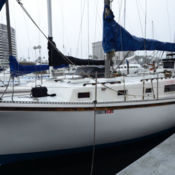 NO RSRV-SPACIOUS GLOBAL CRUISER- $8K Diesel Engine Runs Exlnt. PERFECT 4 ISLANDS
NO RSRV-SPACIOUS GLOBAL CRUISER- $8K Diesel Engine Runs Exlnt. PERFECT 4 ISLANDS
Model: 1974
Year: 1974
Location: Marina del Rey, California, United States
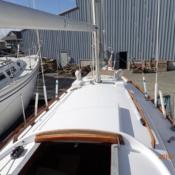 GLOBALLY RENOWED, FULL KEEL BRISTOL CRUISER -Perfect 4 Couple 2 Sail the World
GLOBALLY RENOWED, FULL KEEL BRISTOL CRUISER -Perfect 4 Couple 2 Sail the World
Model: 1974
Year: 1974
Location: Greenport, New York, United States
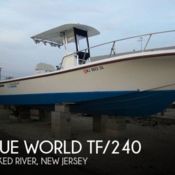 2002 True World TF/240 Used
2002 True World TF/240 Used
Model: 2002
Year: 2002
Location: Forked River, New Jersey, United States
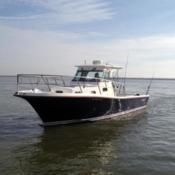 True World Master Marine 300 HP Diesel. Like-Down East, Carolina Classic
True World Master Marine 300 HP Diesel. Like-Down East, Carolina Classic
Model: 2000
Year: 2000
Location: Somers Point, New Jersey, United States
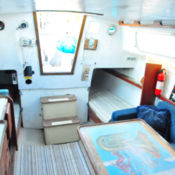 NO RESERVE - Rugged Medium Size Global Cruiser XLent Single Handing/Couple CAL30
NO RESERVE - Rugged Medium Size Global Cruiser XLent Single Handing/Couple CAL30
Model: 1971
Year: 1971
Location: Fort Monroe, Virginia, United States
 True World Marine 300HP Yanmar Diesel, fishing boat, Walk around, center console
True World Marine 300HP Yanmar Diesel, fishing boat, Walk around, center console
Year: 2000
Location: Somers Point, New Jersey, United States
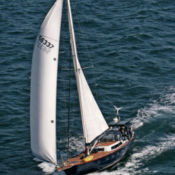 Crealock Design 50ft Del Rey Flush Deck Cutter outfit for world cruising
Crealock Design 50ft Del Rey Flush Deck Cutter outfit for world cruising
Model: 1978
Year: 1978
Location: Antalya, Turkey
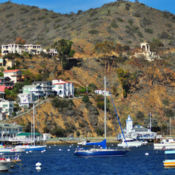 HUGE INTERIOR- GORGEOUS WORLD CRUISER in Mystical Island Paradise NO RESERVE
HUGE INTERIOR- GORGEOUS WORLD CRUISER in Mystical Island Paradise NO RESERVE
Model: 1978
Year: 1978
Location: Avalon, California, United States
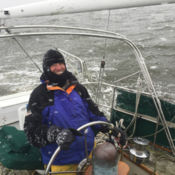 NO Reserve 4OFT LOCALLY FAMOUS WORLD CRUISER - Full Blue-Water Cruising Package
NO Reserve 4OFT LOCALLY FAMOUS WORLD CRUISER - Full Blue-Water Cruising Package
Model: 1994
Year: 1994
Location: Rock Hall, Maryland, United States
 Round the world Ideal live-aboard cruiser
Round the world Ideal live-aboard cruiser
Model: 1979
Year: 1979
Location: Saint Thomas, Virgin Islands, United States
